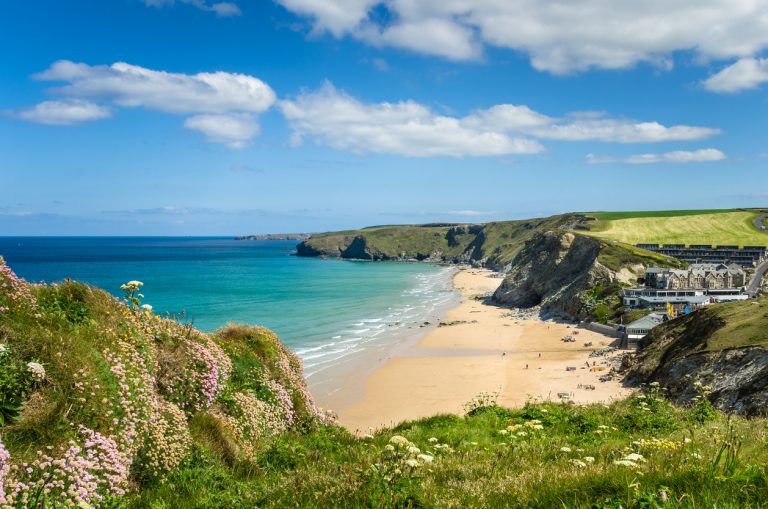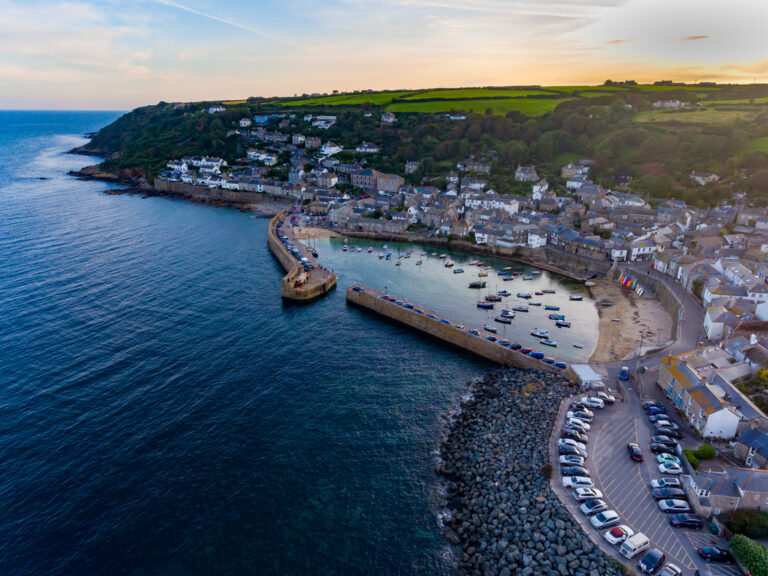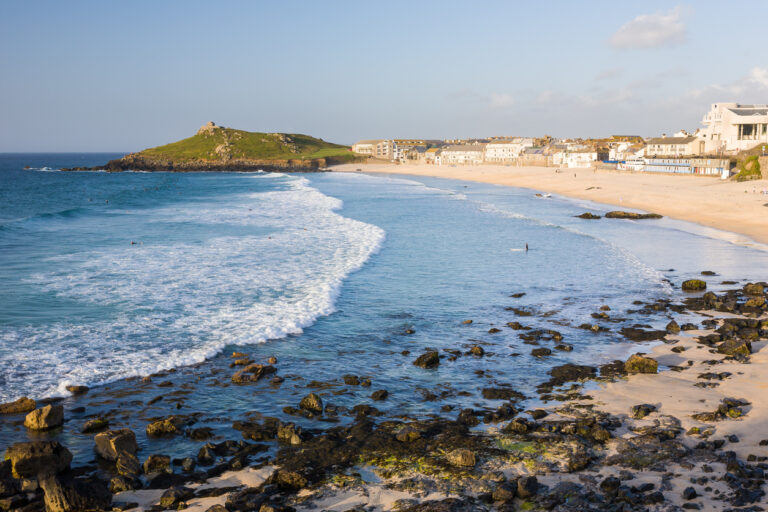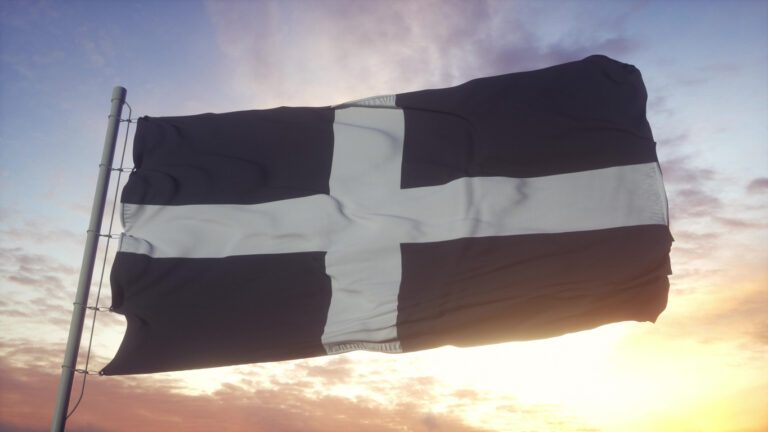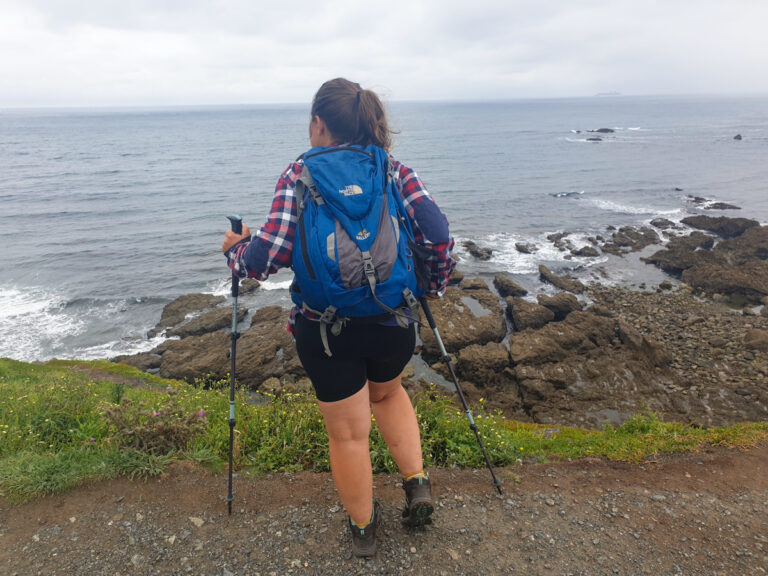15 best fishing villages in Cornwall (2024 guide)
Are you searching for the best fishing villages in Cornwall? You’re in luck with this full guide, which features my favourite 15 in the county!
These charming Cornish villages are nowadays some of the most beautiful parts of the county, but they constantly echo stories of their past.
The days of having a full fishing fleet are long-gone for many, but all that I’ve recommended on this list retain some of their historic charms, with thatched cottages and scenic harbours.
For me, it’s like taking a step back in family history; I come from a very long line of Cornish ancestors who lived all around the region, so I love visiting these villages and imagining my family roots being intertwined with the generations of fishermen who have lived here.
Nowadays, I live over the River Tamar in Devon, but I visit Cornwall frequently (I still have family living here) and I spent an entire summer living in Cornwall and exploring its villages.
So, what are the best coastal villages in Cornwall? We’ll delve into them in this full blog post, peppered with my expert tips to make the most out of visiting them!
What are Cornwall’s fishing villages?
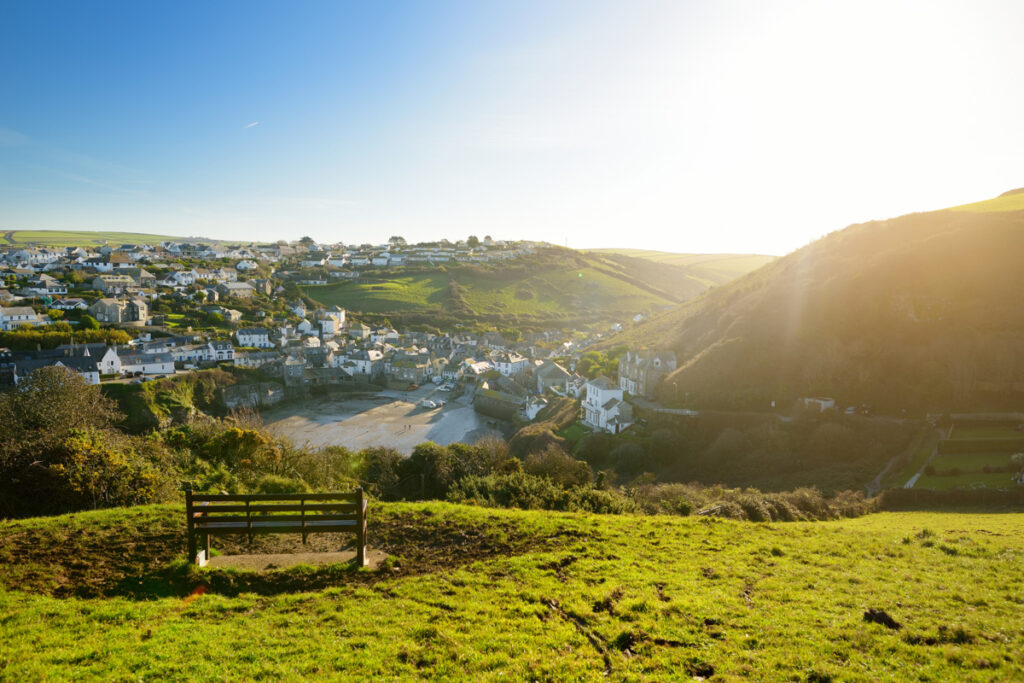
Cornwall fishing villages are historic settlements, usually very small in size, that are built around the fishing industry.
Usually, they’re characterised by a charming harbour and small fishermen’s cottages, many of which are now holiday homes.
As fishing is now much more industrial than it was when these villages were created, these villages are typically not used for fishing nowadays; instead, their historic atmosphere and coastal charm have caused them to become tourism hotspots.
Best fishing villages in Cornwall
The best fishing villages in Cornwall include Mousehole, Port Isaac (home of the popular TV series, Doc Martin), Polperro, Cadgwith, Portreath and St Agnes. Take a look at my favourite villages, with helpful hints about what to do while you’re in town!
Mousehole
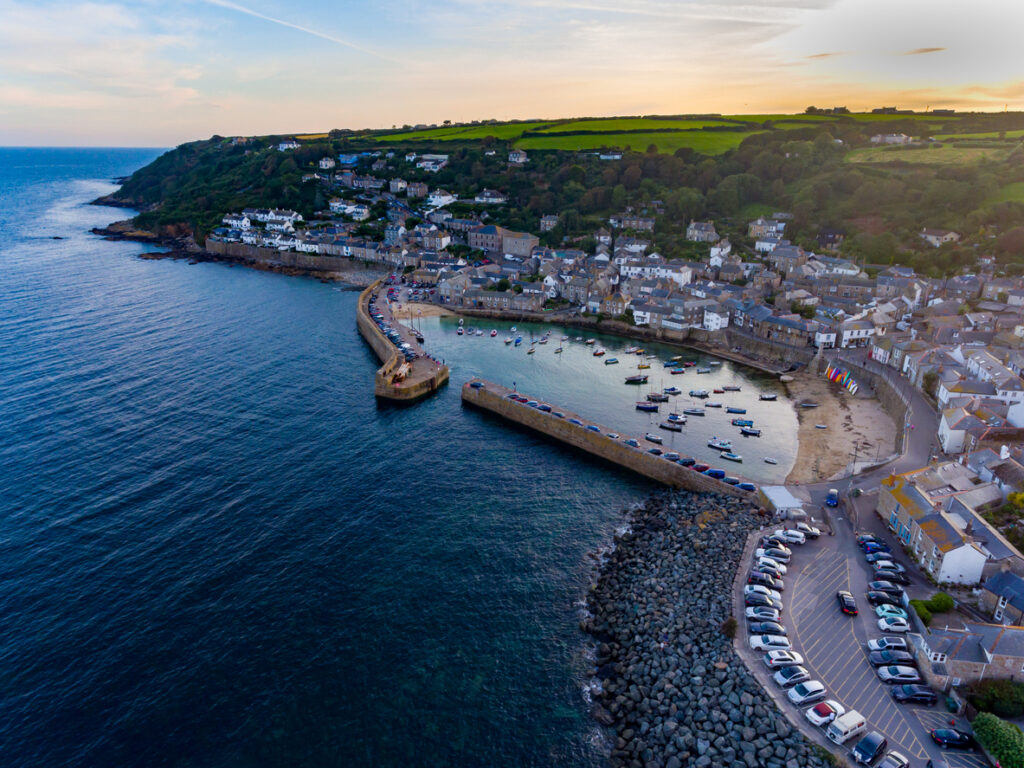
Step into enchanting Mousehole, one of Cornwall’s most spellbinding fishing villages.
Nestled in Mount’s Bay, along the coast from Penzance and not too far from Land’s End, this village is an absolute delight for the senses.
Picture-perfect and brimming with history, you’ll be captivated by Mousehole’s charm – it’s straight out of a postcard!
But Mousehole isn’t just a pretty face—it has plenty of stories to tell.
Dive into the depths of its past, where tales of a devastating fire, set ablaze by the Spanish centuries ago, still linger in the air.
Discover the origins of stargazy pie, a pie made with fish heads (definitely not as mainstream as Cornish pasties!).
And pay homage to the people lost in the tragic Penlee lifeboat disaster, a harrowing reminder of the danger of Cornish seas.
You can learn all about this fascinating history on a walking tour with local guide Elaine – more information here.
Yearning for adventure? Grab a paddleboard and embark from the petite yet picturesque beach.
Back on land, take a moment to immerse yourself in the lively atmosphere. Sit by the harbour and listen to the squawk of seagulls.
Or wander through quirky shops and sip on a revitalising drink at the Mousehole Deli & Kitchen.
And when the day draws to a close, relish the cool vibe at the Ship Inn—a perfect finale to your Mousehole escapade.
Mousehole faces its challenges, with an influx of holiday accommodation overshadowing local homes.
It is an idyllic place to stay, but I always feel a bit uncomfortable that it’s very much nowadays a tourist village – our guide Elaine explained that, although she was born and bred in Mousehole she actually lives in nearby Penzance these days, because housing is a lot cheaper.
(She told us that her grandparents bought a small cottage for £6,000 and it was last sold recently for £350,000!).
Because of this, I’ve always stayed outside Mousehole; such as nearby Penzance, which is just a short drive away.
Whether you’re staying in Penzance or not, I’d recommend leaving your car at the Harbour Car Park and hopping aboard the M6 bus, which effortlessly connects the vibrant town with the village, sparing you the hassle of parking woes and allowing you to fully indulge in the magic of Mousehole.
Check out the best things to do in Mousehole with my full guide.
Port Isaac
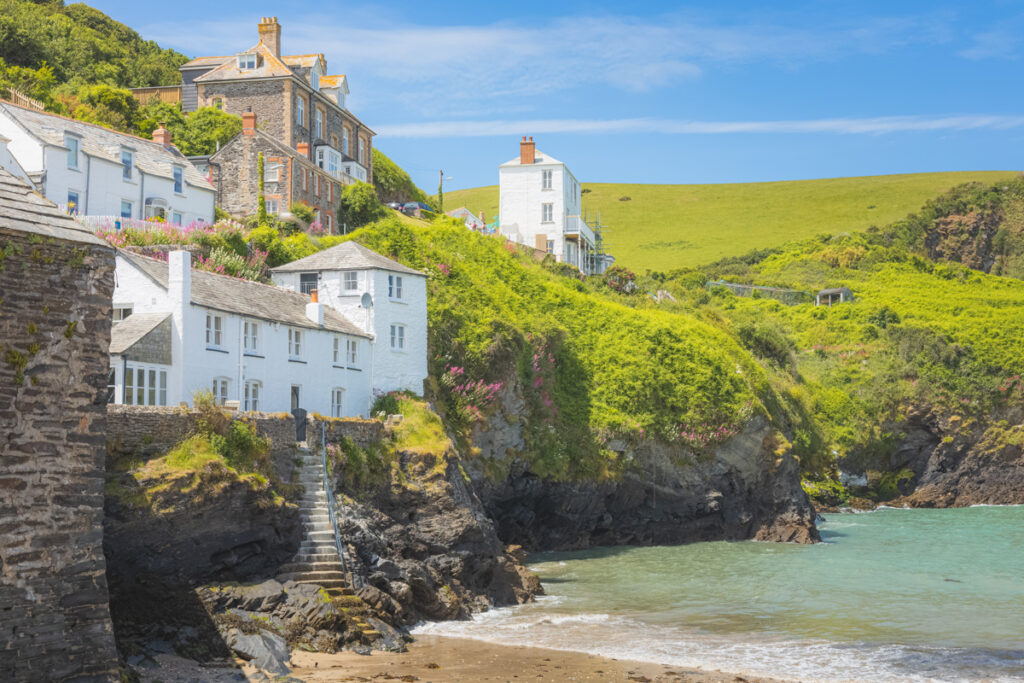
Port Issac is a picture-postcard village that will captivate both Doc Martin fans and non-fans alike.
As you stroll through the narrow streets, you’ll discover the real-life locations behind the popular TV show.
Keep an eye out for Fern Cottage, the iconic house of the grumpy Doc Martin, and the Old School Hotel, which was the primary school in the TV series!
Doc Martin enthusiasts won’t want to miss the chance to explore these premier locations and immerse themselves in the show’s magic – you can even do a Doc Martin tour to learn the series’ hidden secrets.
Click here to read more about this tour – I did it a couple of years ago and it gave me an incredible look behind the scenes and taught me a little about Port Isaac’s history.
But even if you’re not a fan of the series, Port Isaac has plenty more to offer.
You’ll be enchanted by its idyllic harbour views and picture-perfect fishing cottages.
If you’re in the mood to relax, head to The Slipway, a pub with an al-fresco dining area right by the harbour, where you can savour a delicious burger accompanied by the refreshing taste of Rattler’s cider, a local favourite.
If you’re up for more adventure, Port Isaac serves as an excellent starting point for boat trips out to sea or scenic walks to nearby destinations like Padstow or Tintagel.
This part of the Cornish coastline is one of the hardest sections of the South West Coast Path, but the spectacular vistas make it absolutely worth it.
Check out my full guide to Port Isaac by clicking here.
Polperro
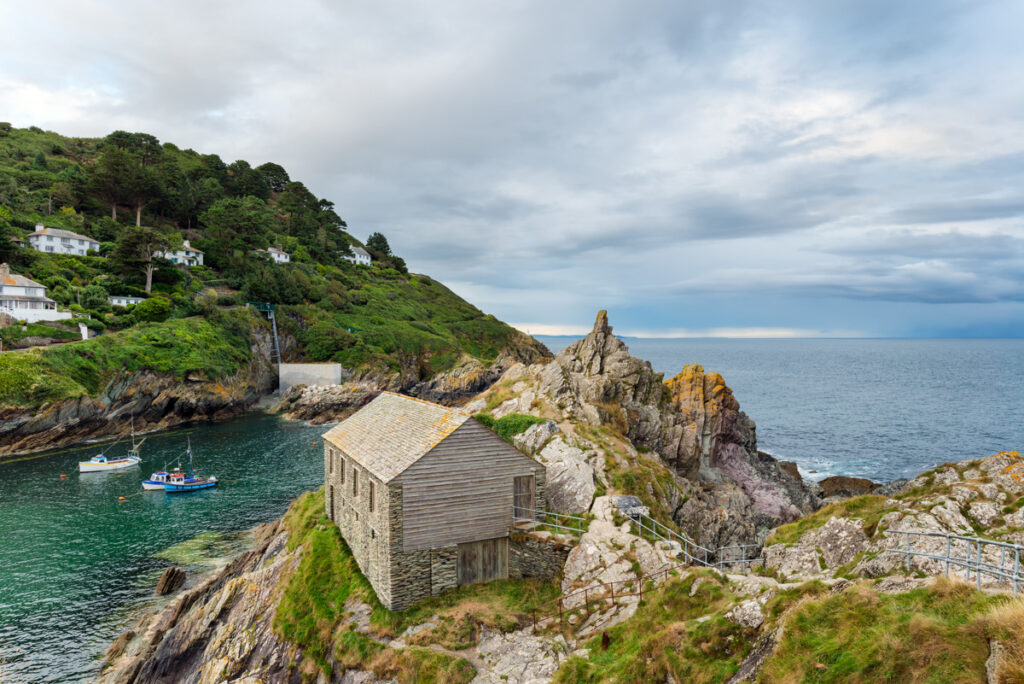
Discover the beauty of Polperro, one of Cornwall’s most exquisite villages.
Nestled along the coastline, this charming gem offers a delightful blend of natural splendour and rich history.
Once a thriving smuggling hotspot, Polperro still echoes with tales of clandestine activities.
Immerse yourself in its intriguing past by visiting the Polperro Heritage Museum of Smuggling and Fishing, where you can unravel the secrets of the village’s notorious trade.
Also look out for Willy Wilcox’s Cave, a hidden cavern associated with the smugglers of old.
As you meander through Polperro’s winding cobblestone streets, you’ll be enchanted by the quaint fishing cottages that line the roads.
Each one tells a story, preserving the village’s timeless charm.
Don’t miss the mesmerizing Shell House, adorned with a mosaic of thousands of delicate shells—an exquisite sight that showcases the creativity and craftsmanship of the locals.
While Polperro can become a hive of activity during the summer months, there’s a distinct allure to be found in its tranquil winter season.
As the tourists retreat, the village regains its peaceful atmosphere, inviting you to appreciate its beauty at a more leisurely pace.
I visited last winter, walking from Looe and loved having the village mostly to ourselves.
Polperro also boasts a selection of delightful shops to explore. Indulge your taste buds at the Cornish Chilli Company – the owner is lovely and will happily talk chilli to you for a while – or visit The Doghouse Deli & Bar, which is a bar for your dog – they even offer doggie photoshoots!
Hungry? I adore the Blue Peter Inn, a wonderful pub adorned with fascinating memorabilia and offering a great vegetarian menu – I had battered “fish” and chips when I was there (and my boyfriend had the non-veggie version, thumbs up from both of us!).
The Polperro to Looe hike is well worth doing – it’s a scenic trail that takes you over cliffs and provides breathtaking coastal vistas.
Plus, the settlements are connected with fairly regular (for Cornwall, at least!) buses.
Check out my full guide to Polperro!
Cadgwith
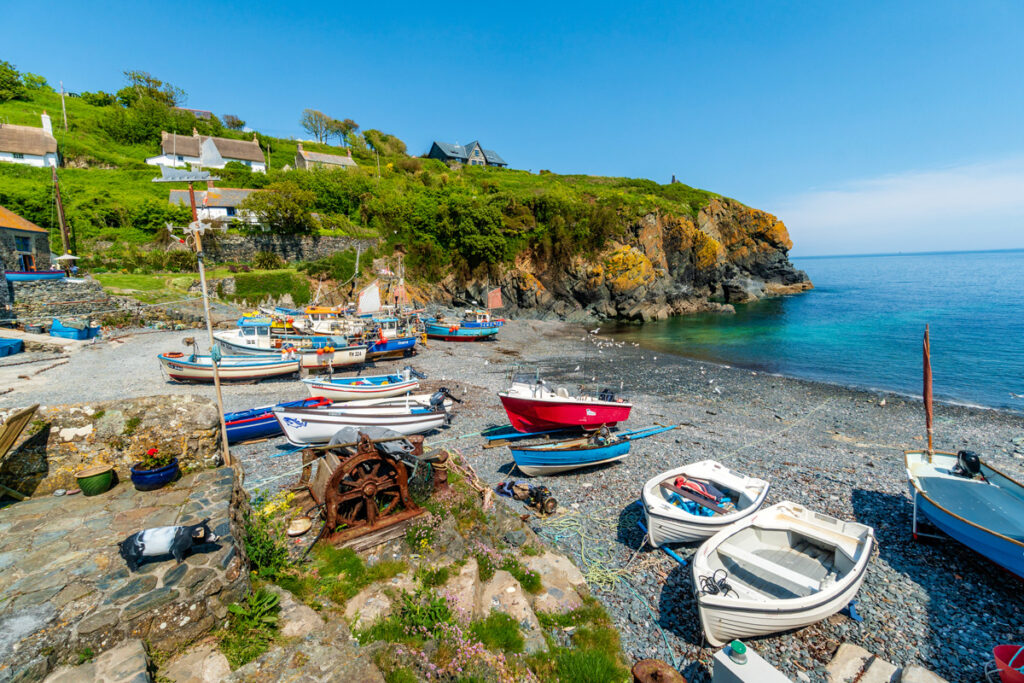
Nestled near Lizard Point on the Lizard Peninsula, Cadgwith is a hidden gem and in my humble opinion, possibly the last authentic fishing village in Cornwall (let me know if you think any others deserve this accolade!).
Unlike its more touristy counterparts such as Mousehole or Port Isaac, Cadgwith retains a sense of tranquillity and charm that will leave you enchanted.
Though reaching Cadgwith is a bit of a trek – you’ve basically got to drive right to the bottom of the country – it is undoubtedly worth the effort (plus, The Lizard is one of the loveliest stretches of the Cornish coastline!).
Once you arrive, settle into the rhythm of this idyllic fishing harbour, where the scent of the sea mingles with what’s got to be the freshest air in the UK.
With its quiet shores and two small beaches, Cadgwith remains an active fishing village, providing an authentic glimpse into an often-forgotten way of life.
The heart of Cadgwith revolves around the Cadgwith Cove Inn, one of the few places to stay in the village.
Its delightful rooms above the pub offer a comfortable retreat, while the menu showcases delectable dishes.
During my visit, I devoured a buttery vegetarian pasta that rivalled anything I had tasted outside of Italy!
Friday nights at Cadgwith Cove Inn offer a special treat—an opportunity to immerse yourself in the local culture.
The air fills with the soulful melodies of Cornish songs as locals gather for a heartfelt singing session.
Want to stretch your legs in the morning? Head to the nearby Devil’s Frying Pan.
This striking rock formation just beyond the village along the coastal path showcases the raw beauty of the Cornish coastline.
If you’re up for more, consider journeying all the way to Lizard Point, the southernmost tip of mainland UK.
Check out the best things to do in The Lizard by clicking here.
Boscastle
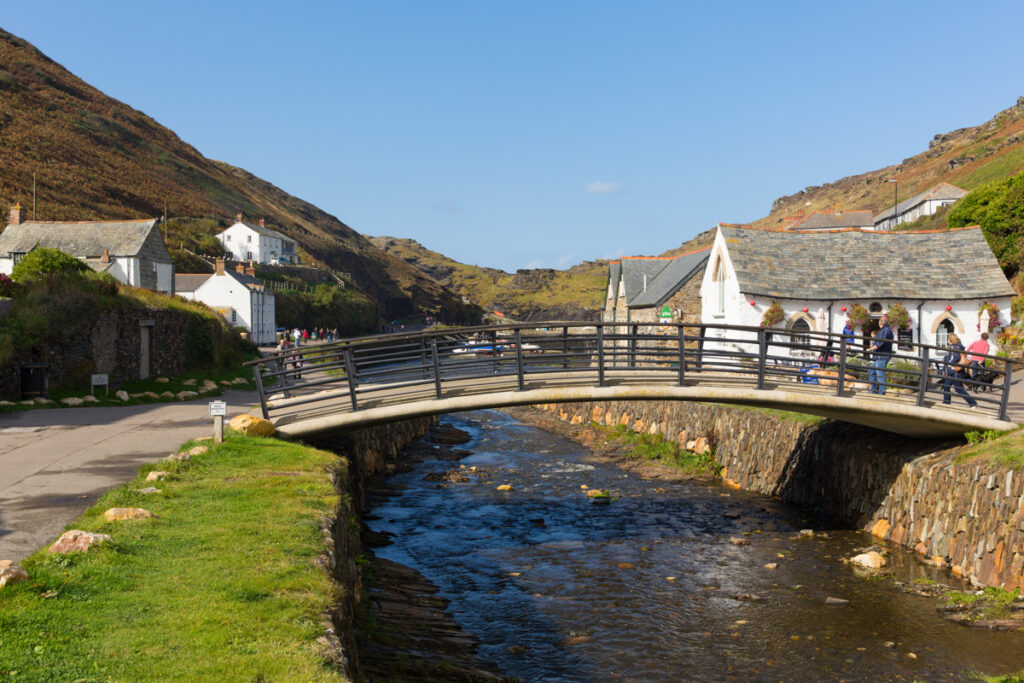
Perched on the dramatic north coast, Boscastle is a charming yet minuscule village owned by the National Trust.
Its claim to fame lies in its stunning natural harbour, an exquisite inlet that stands as a testament to the area’s unique beauty.
In times past, this picturesque harbour was a thriving port – there was none of its size of the north Cornwall coastline – played a vital role in the village’s history, but in today’s modern world, it functions as a tourist-centric village.
Yet Boscastle remains steeped in myth and legend, the Museum of Witchcraft being the perfect gateway to explore its mystical past.
Delve into fascinating tales of “witches” who would allegedly “bottle the wind” and sell it to sailors, promising them favourable sailing conditions.
Once you’ve explored the village, venture to the nearby surroundings and discover enchanting waterfalls such as Rocky Valley and St Nectan’s Glen.
These natural wonders add an ethereal touch to the already spellbinding landscape.
The downside of visiting Boscastle?
Well, someone made headlines recently claiming it was unnerving and he wouldn’t return.
The Mirror put this down to its spooky history, thanks to its haunted pubs and witchcraft.
But, in a few Cornwall groups that I’m a part, of there were discussions about the village’s businesses being slightly unwelcoming to tourists.
I experienced this a little on my last visit there; we were quite surprised at how poor the service was in restaurants, which isn’t the norm in the rest of Cornwall!
So, by all means, visit Boscastle, but do bear this in mind!
Here’s my guide to the best things to do in Boscastle.
Portreath
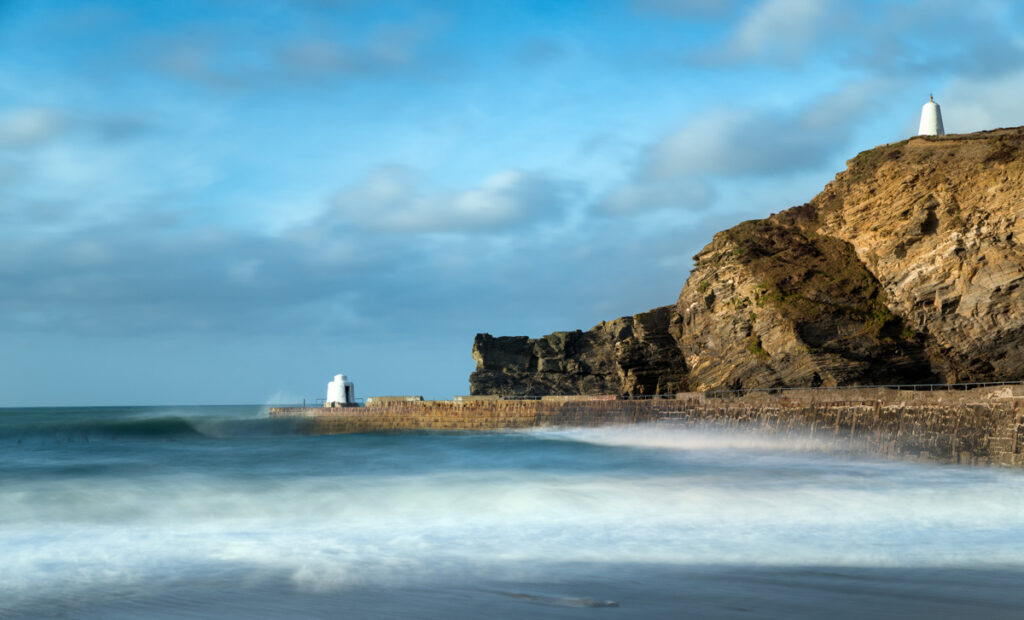
Situated between St Ives and St Agnes, Portreath sits amongst the heritage coast and offers a peaceful retreat away from the busier hotspots of Cornwall like St Ives or Newquay.
While it does attract some tourists, there’s always a sense of tranquillity to be found here!
My grandma was born in Portreath, and it’s just a 10-minute drive away from my family in Camborne, so I’ve visited a lot over the years.
One of the highlights of Portreath is surfing, with a dedicated surfing school (aptly named Portreath Surfing School and Hire Centre) available for those looking to ride the waves.
Whether you’re a seasoned surfer or a beginner eager to learn, the coastal waters of Portreath provide an ideal playground.
If hiking’s more your cup of tea, Portreath offers scenic walks along the cliffs, allowing you to soak in the breathtaking coastal vistas while relishing the tranquillity of a less crowded setting.
For those seeking a longer adventure, a walk to Hayle is highly recommended.
Along the way, you’ll be treated to awe-inspiring stretches of coastline, where dramatic cliffs paint a stunning backdrop.
Don’t miss Mutton Cove, known as one of the best spots to see seals in Cornwall.
Rock
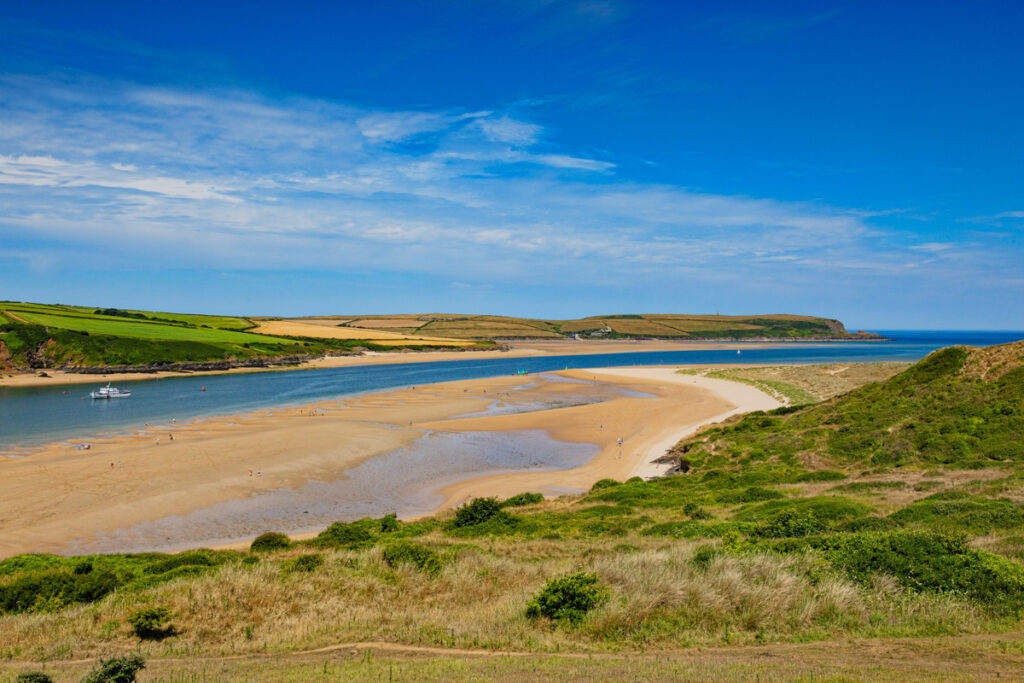
Perched on the banks of the Camel Estuary, glamourous Rock sits opposite Padstow (the harbour town that Rick Stein made famous by opening his restaurants!).
Renowned for its celebrity appeal, many high-profile individuals have chosen to buy property in this village.
Rock boasts a selection of upscale bars and restaurants, where you can indulge in fine dining experiences.
For a taste of sophistication, I highly recommend The Blue Tomato or The Rock Inn, which boasts incredible estuary views.
After enjoying some delicious cuisine, stroll along the water’s edge and soak in the beauty of the Camel Estuary.
If you’re up for more adventure, you can even embark on a scenic walk up to Polzeath, a popular surfing destination.
Crackington Haven
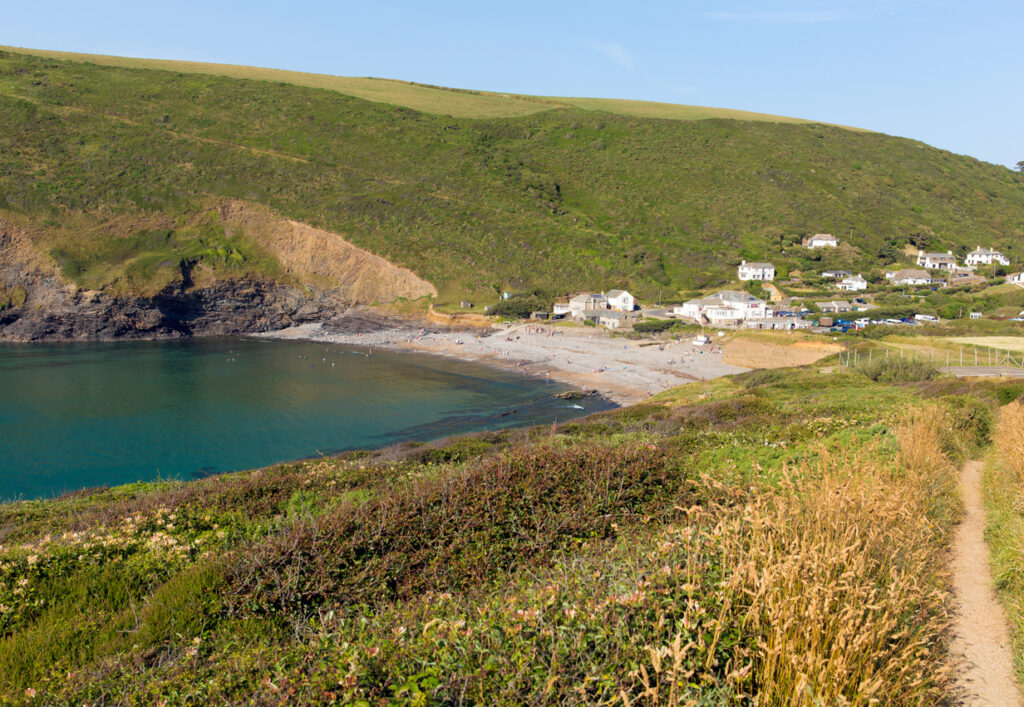
Nestled amidst Cornwall’s breathtaking northeast coastline lies Crackington Haven, a serene and relaxed beach.
This hidden gem, often visited by geologists, beckons with its unique sandstone layers, which are part of the renowned Crackington Formation.
While the area’s fossil treasures have become scarce due to over-collection, Crackington Haven still allures visitors with its remarkable rock pools teeming with crabs, shells, and other fascinating marine life during low tide.
Though small in size, Crackington Haven is home to a close-knit community, adding a warm and welcoming touch to its peaceful ambience.
However, Crackington Haven is usually quite quiet (there’s not even any signal down in the cove!), so it’s a lovely village to visit if you’re looking for somewhere off the tourist trail.
Coverack
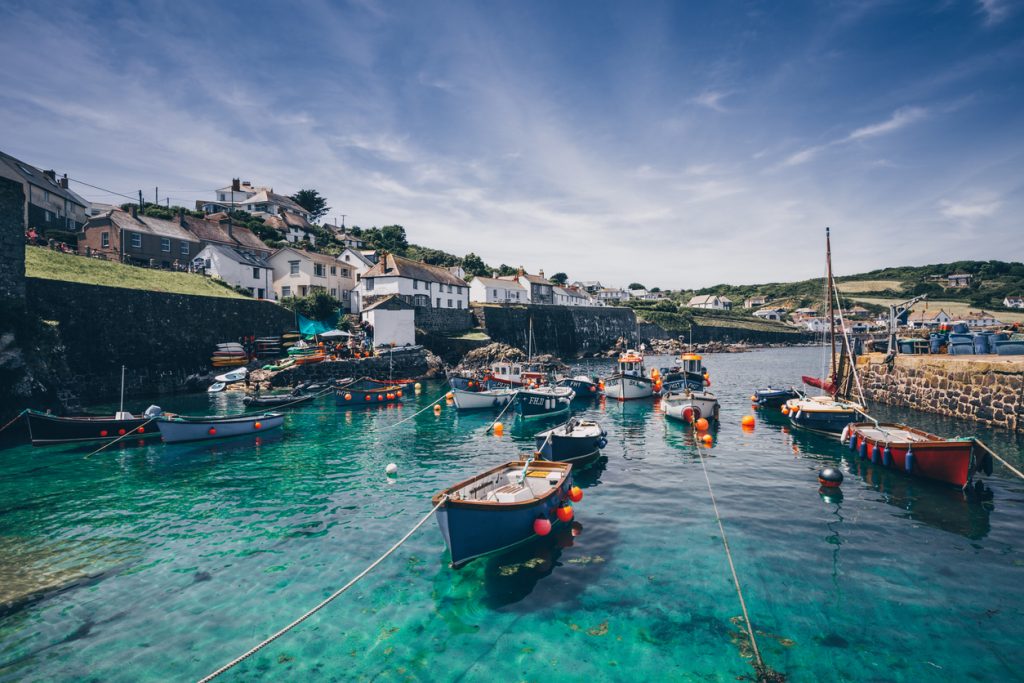
Located on the Lizard Peninsula, Coverack Harbour beckons visitors.
Home to a long beach that gracefully spans the coastline, stretching away from the harbour into the distance, Coverack’s quite sizable in terms of Lizard villages.
At first glance, the beach may appear rocky during high tide, but as the waters recede, a generous expanse of golden sand reveals.
Coverack Harbour, with its picturesque allure and rich history dating back to 1724, serves as a testament to the village’s maritime past.
Once a bustling hub for pilchard shipments from the Lizard, the harbour and historic fishing boats stand as a reminder of the region’s seafaring heritage.
For those seeking adventure on the waves, Coverack is a haven for watersports enthusiasts.
The Coverack Windsurfing Centre presents an excellent opportunity to learn the art of windsurfing, while kayaking and paddleboarding options abound.
Check out the best beaches on the Lizard Peninsula with my full guide.
Charlestown
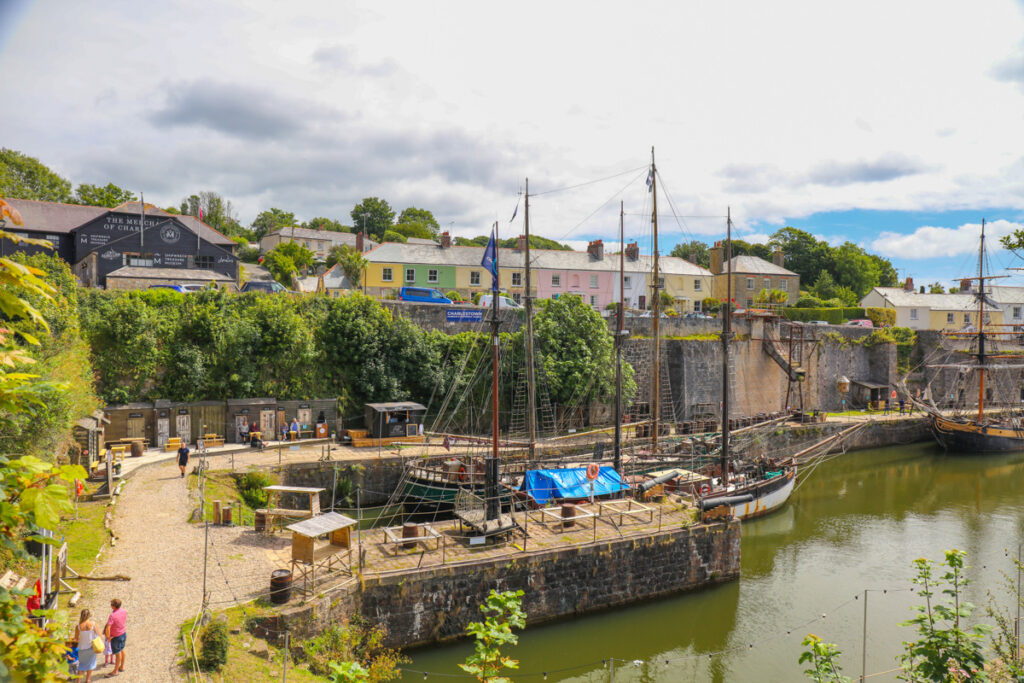
Charlestown is a village frozen in time.
It started life as a serene fishing village, but thanks to Charles Rashleigh (who the town was named after!), it became one of the biggest ports in the country, and now stands as a proud UNESCO World Heritage Site.
The 18th-century harbour’s iconic tall ships, gracefully moored alongside the quay, evoke visions of a bygone era when Charlestown was a bustling hub of maritime trade.
Charlestown’s narrow streets are lined with charming fishermen’s cottages, painted in hues of blue and white, some of which were used as a backdrop for the filming of Poldark (and countless other films and TV shows!).
For history enthusiasts, Charlestown’s Shipwreck and Heritage Centre is a treasure trove of maritime tales.
Explore the exhibits and artefacts that bring to life the village’s rich seafaring heritage, providing a fascinating glimpse into its past.
Beyond its historical charm, Charlestown also boasts stunning coastal views.
Take a leisurely walk along the rugged cliffs, drink in the panoramic vistas of the turquoise sea, and breathe in the fresh sea breeze.
Take a look at my full guide to Charlestown.
Tintagel
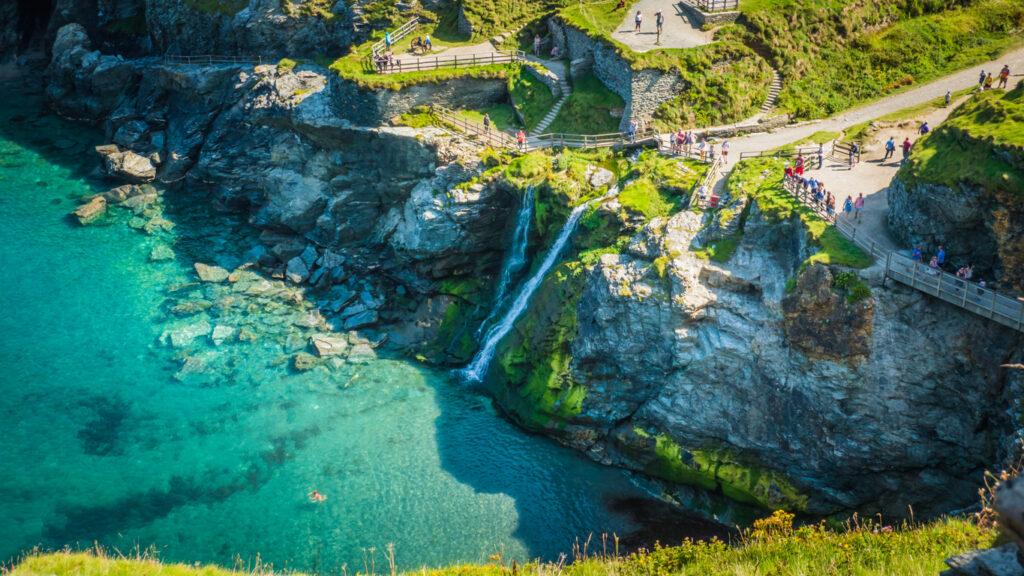
Tintagel, a striking coastal village high on top of the cliffs of Cornwall’s north coast, effortlessly weaves together history, natural beauty, and a vibrant atmosphere.
It’s a bit different from the other villages on the list, but there certainly was fishing from here at some point or other… and it’s coastal – so we can count it!
Home to the renowned Tintagel Castle, which Geoffery of Monmouth claimed as the birthplace of the legendary King Arthur in the 13th century (the legitimacy of which has been debated!).
Since then, it has grown into one of the premier tourist destinations in the South West, drawing visitors from far and wide to explore the castle’s ancient ruins and immerse themselves in the mystique of Arthurian legend.
King Arthur may or may not have been built there (in fact, he may or may not have been alive), but the castle was most certainly the seat of Cornish kings until the 5th century, and it was owned by Richard, Earl of Cornwall, in the 13th.
Once you’ve admired the castle, stroll through the village to discover an array of fascinating museums, including the National Trust Tintagel Post Office, which is set in a rare medieval hall house, and the Tintagel Toy Museum – which is one of the best free things to do in Cornwall!
Don’t miss the immersive experience of King Arthur’s Great Halls, where you can step into the mythical world of Arthurian tales.
Once you’ve explored the village (it’s quite small, so won’t take you too long!) head out on the dramatic coastline, with its breathtaking cliffs and panoramic vistas.
Head out on the Boscastle to Tintagel walk to explore some of Cornwall’s most staggeringly rugged coast and see why it’s such an attractive tourist destination, time and time again.
Check out the best things to do in Tintagel by clicking here.
St Mawes
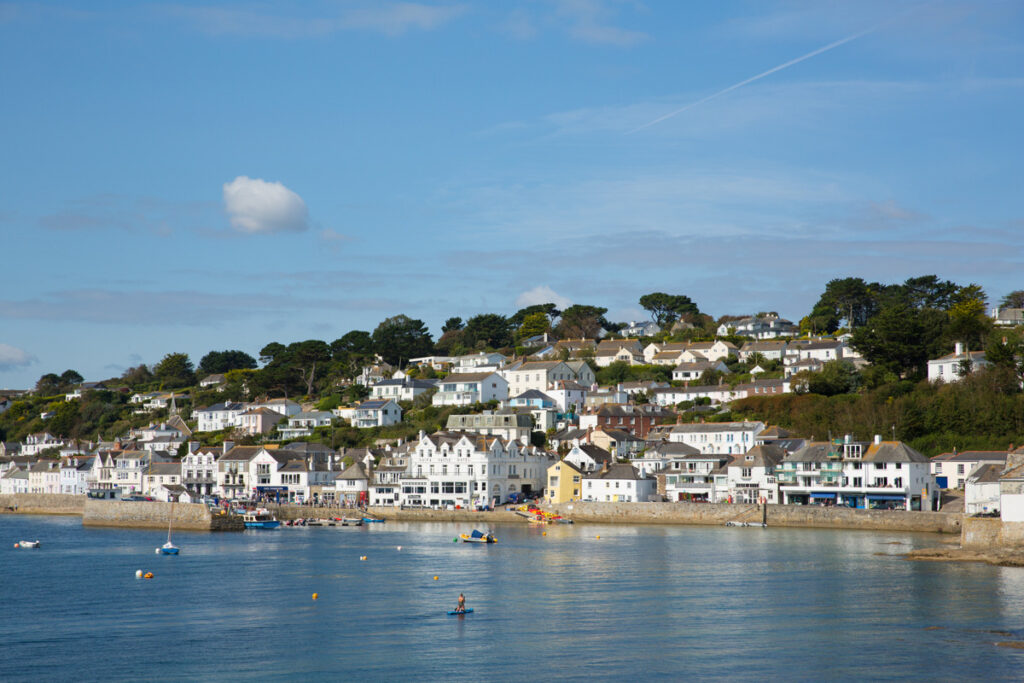
If you’re staying in or visiting Falmouth, head over to St Mawes – which is definitely one of the most iconic Cornish fishing villages!
Enjoy panoramic vistas of the glorious harbour as you glide over Carrick Roads towards St Mawes.
At the heart of St Mawes stands a testament to history is St Mawes Castle.
Constructed during the reign of King Henry VIII to safeguard the Fal Estuary, this remarkable fortress stands proudly alongside its counterpart on the other side of the river, Pendennis Castle.
Though smaller in size and less famous, St Mawes Castle is a gem worth exploring, offering glimpses into the past through its engraved depictions of Henry VIII and Edward I.
From the castle’s vantage point, be captivated by breathtaking vistas that stretch across the estuary, taking in Pendennis Point and Falmouth in the distance.
The awe-inspiring views are a constant reminder of the region’s rich maritime heritage and its enduring allure.
While St Mawes enjoys close proximity to Falmouth, it exudes a distinct charm and tranquillity, making it an ideal retreat if you fancy a bit of P&Q after exploring the coastal harbour town.
St Agnes

The cliffs of Cornwall’s mining heritage coast cascade down into the village of St Agnes, which is divided into a beachside and clifftop area.
I’ve hiked most of the Cornish coast path, and this segment was a particular highlight!
When it comes to beaches, St Agnes is home to the picturesque Trevaunance Cove Beach.
This idyllic stretch of sand not only provides a safe haven for swimming but also offers a selection of charming eateries, including the Driftwood Spars pub.
This gem not only serves mouthwatering food but also treats you to mesmerizing views of the village and coast.
Flushing
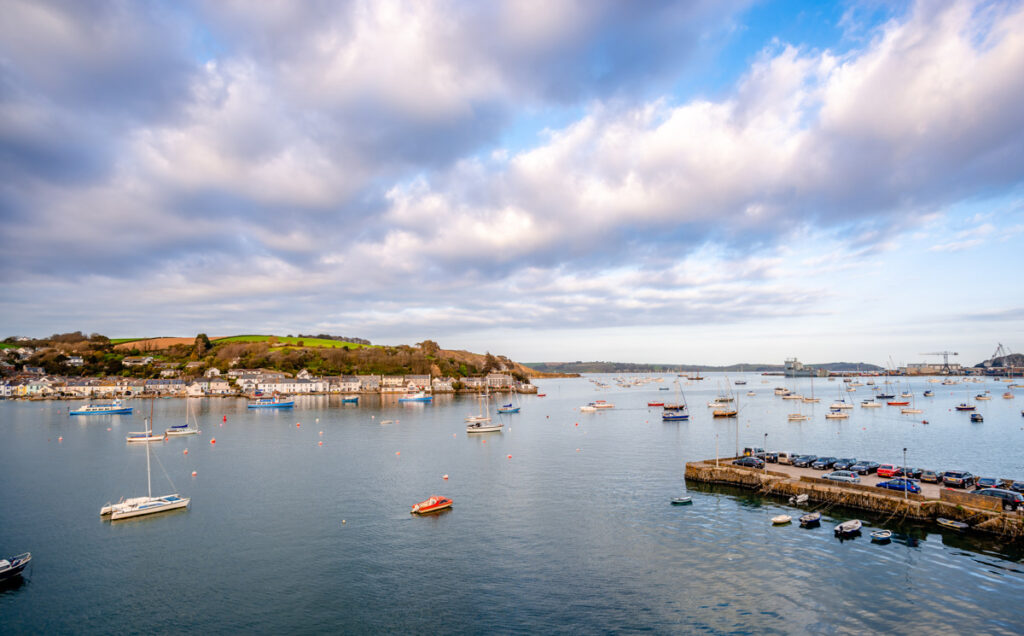
Another enchanting fishing village in striking distance to Falmouth, Flushing is a quiet and picturesque village with a laidback atmosphere.
Take leisurely strolls through its winding lanes and immerse yourself in the timeless beauty that surrounds you.
There’s not a huge amount to do in Flushing, but it’s a wonderful place to spend a sunny afternoon, soaking in authentic Cornish charm.
Interestingly, the quaint fishing village derives its name from Flushing in the Netherlands.
This connection traces back to the Dutch engineers who played a pivotal role in constructing the three main quays that grace Flushing’s waterfront.
To reach Flushing, take a short 10-minute ferry ride from the Prince of Wales Pier in Falmouth.
Mevagissey
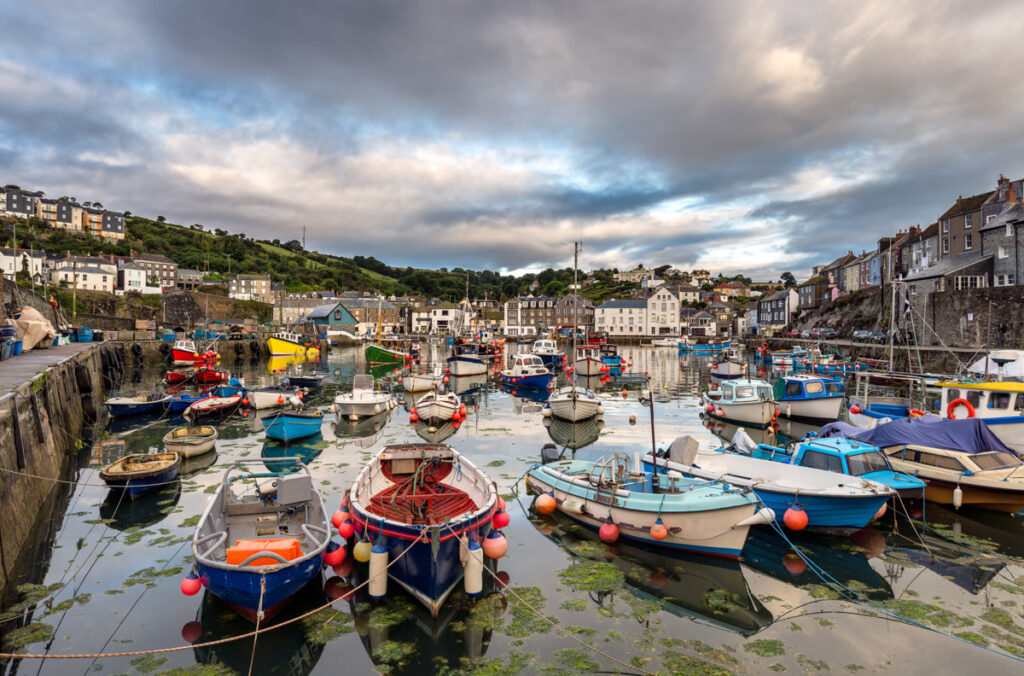
One of Cornwall’s top towns when it comes to seafood and maritime charm, Mevagissey is a coastal haven that captures the essence of Cornwall’s fishing heritage.
With narrow winding streets, colourful cottages, and a bustling harbour filled with bobbing fishing vessels, this charming village offers some authenticity that’s lost in other Cornish coastal towns.
Seafood lovers will be in paradise in Mevagissey – it was once the capital of the pilchard fishing industry.
As you stroll along the waterfront, you’ll be enticed by the aroma of freshly caught fish and shellfish.
From traditional fish and chips to gourmet seafood restaurants like Salamander, the culinary offerings here are a seafood enthusiast’s dream.
Indulge in the catch of the day, savour succulent crab sandwiches, or feast on a platter of locally sourced oysters.
You can also immerse yourself in Mevagissey’s rich maritime history by exploring its intriguing attractions.
Visit the Mevagissey Museum, housed in a former school building, where you can discover the village’s seafaring past through fascinating exhibits and artefacts.
Step aboard the Mevagissey Ferries for a boat trip – some of which sail all the way over to Fowey!
As you wander through Mevagissey’s charming streets, don’t miss the opportunity to explore its hidden corners and unique shops.
You’ll discover a treasure trove of nautical-themed trinkets, handmade crafts, and local artwork that reflect the village’s maritime spirit.
For nature enthusiasts, Mevagissey offers easy access to the stunning South West Coast Path, which winds its way along the rugged cliffs, offering breathtaking views of the sea and surrounding landscapes.
There are also plenty of nearby attractions like the wonderful Lost Gardens of Heligan, which (as the name suggests) were literally lost over time.
Whether you’re seeking a culinary adventure, a glimpse into Cornwall’s seafaring past, or an escape into nature’s embrace, Mevagissey delivers. Step into this wonderful coastal town and enjoy its charms!
Check out the best things to do in Mevagissey by clicking here.
FAQs about Cornwall fishing villages
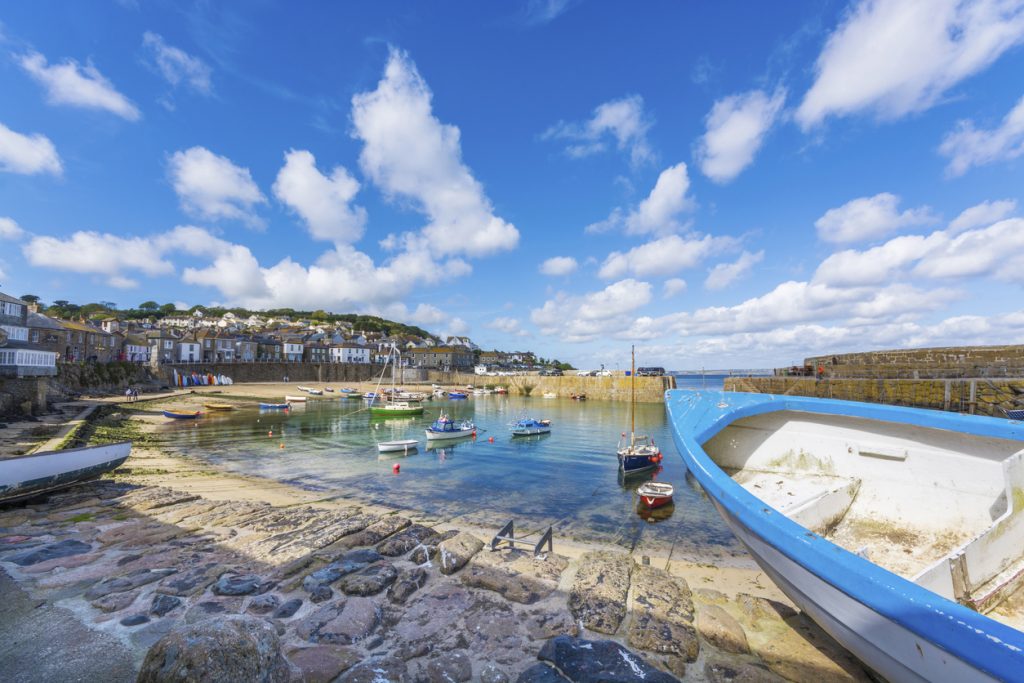
What is the loveliest fishing village in Cornwall?
Cadgwith is often regarded as one of the loveliest fishing villages in Cornwall. Its picturesque harbor, thatched cottages, and stunning coastal scenery make it a charming destination for visitors seeking a quintessential Cornish fishing village experience.
What is the oldest fishing village in Cornwall?
Polperro is considered the oldest fishing village in Cornwall, with a history that can be traced back to at least the 13th century. Its narrow streets, historic buildings, and rich maritime heritage attract visitors from near and far.
What fishing village in Cornwall begins with C?
Cornwall boasts several fishing villages starting with the letter C. Among them, Cadgwith and Coverack stand out for their scenic coastal locations, traditional charm, and vibrant fishing communities.
What is the biggest village in Cornwall?
Millbrook holds the distinction of being the largest village in Cornwall. Situated on the Rame Peninsula, it offers a range of amenities and is known for its proximity to beautiful beaches, countryside, and the stunning Mount Edgcumbe Country Park.
Are there free fishing villages in Cornwall?
Yes, unlike Clovelly in North Devon, where an entrance fee is required, visitors can explore and enjoy the fishing villages of Cornwall without any additional cost. You can freely discover the charm and beauty of places like Cadgwith, Polperro, and more.
Are you ready to visit Cornwall’s fishing villages?

Cornwall is a treasure trove of beautiful fishing villages that will enchant you from the moment you step in!
From the rugged beauty of Charlestown to the legendary tales of Tintagel, from the tranquility of Crackington Haven to the hidden gem of Flushing, and from the coastal delights of St Mawes to the captivating landscapes of Coverack and St Agnes, each of these villages offers its own unique character and attractions.
Whether you’re a history enthusiast, a nature lover, a seafood connoisseur, or simply seeking a peaceful retreat by the sea, Cornwall’s idyllic fishing villages have something to offer for everyone.
I hope that this article has proved useful. Do check out the rest of my Cornwall guides – I’ve covered most of the region’s highlights – and feel free to reach out on Instagram if you have any questions!

